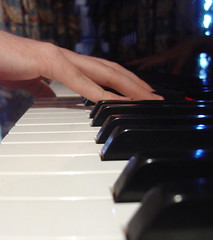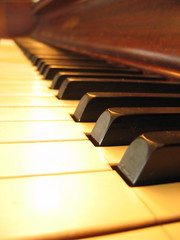Learning Piano
In my recent post on learning in China, I mentioned that I started piano lessons this month. Some of my experiences illustrate nicely a few of the points I made in that post, so I’ll share them here.
A bit of background first. I studied piano just a little bit when I was in high school. I learned the basics of reading music, the notes of the piano keys, etc. Then, about 6 years ago in Hangzhou, I took piano lessons in exchange for English lessons for about half a year. So I’d say I’m still a beginner, but I’m not starting from scratch.
In my first two lessons I’ve taken quite a bit of criticism from my teacher. I don’t pay enough attention to my finger positioning or movements. My left hand accompaniment is not staccato enough, and my right hand isn’t playing the melody smoothly enough. (Who knew Oh Susannah could be so agonizing?)
So here’s how it works out for me linguistically:
Finger positioning. This requires little to no Chinese to learn. I’m hearing things like 不对 (“not right”) and 手指应该这样 (“the fingers should be like this”), all the while being shown the proper form, or, in some cases, having my fingers bent/moved for me. It may be difficult to conform to all the rules, but it’s certainly not hard to figure out what one is doing wrong, no matter the Chinese level.
Vocabulary. I’m hearing a lot of the same words over and over in my lessons: 节奏 (rhythm), 伴奏 (accompaniment), 断奏 (staccato), 连奏 (legato). Hmmm, do you see something these words have in common?
When I first started my lessons, I knew the word 节奏 (rhythm). The rest of the terms mentioned above all kind of made sense in context, and the second syllable zòu, which they all share, isn’t a very common one in Mandarin. So when it wasn’t entirely clear, I was still guessing that each word was somehow related to rhythm. Still, the frequency that those words came up drilled them into my head, and while possibly related, the terms clearly did not mean the same thing as rhythm. So I was compelled to look each one up when I got home, just to make sure I was understanding my teacher correctly. (You muddle through when you can, but once the repetitions reach a certain level, muddling starts to feel silly.) So I’ve already had those new additions to my vocabulary reinforced more strongly than any other words I’ve learned in a long time. This is learning.
Pedagogical background. The biggest difficulty we’re having communicating is that my teacher expects all her students to be familiar with the do re mi fa so la ti do technique for referring to notes in a scale (those in the know seem to call this solfège), but to me, that’s pretty much just just a song in The Sound of Music. I know the notes, and I’m fine with assigning numbers to them, but if you want me to play mi-mi-fa-re in the key of C right now, I’m lost. Fortunately, my teacher is accommodating and switches to names of the notes that I actually understand… when she remembers. I just give her that blank look every now and then to remind her.
My teacher doesn’t use English with me, but she mentioned that she has one or two foreign students with whom she has to use English. (This reinforces my point that speaking Chinese is not an absolute necessity for this stuff.)
Besides learning a few words, I’m starting to feel that I understand just a bit more of the pain of being a Chinese kid. Fortunately there’s still no Chinese mom making me practice piano when I’d rather go play.



Ha! I feel your pain.
When I first began learning my guzheng I had to completely re-teach myself how to read music. Besides being instructed using the “do-re-mi” method you mentioned above (which, if I could just get a handle on it, seems like a great way to train your ear!), the style of writing the music was completely foreign. Numbers with specifically placed dots and lines took the place of the bass and treble clef I am used to.
Unfortunately my guzheng teacher out here in Xinjiang couldn’t speak a lick of English, so everything was trail-and-error!
Glad to see you’re still learning new languages. haha.
Solfege is cumbersome but worth learning, if you intend to go far. I learned it when I was seven. I still use it today.
There’s no Chinese mom, fortunately?? Music is hard work, John. Practice hard 🙂
I’ve actually been thinking/talking about taking some sort of lessons here a lot lately and then I bumped into your posts about the same thing. (even specifically piano!) Good stuff.
It stems from a desire to simply learn more, but also to use my Chinese in ‘productive’ ways. It’s just so much more satisfying that way. And, as you mention, a really good way to learn.
Still not sure if I want to try my hand at calligraphy or do the music thing, but either way it’ll be fun to give it a try.
I got a lot of mileage out of Bach’s variations back in the day. They’re pretty simple pieces, but get you moving up and down the scales in the various keys, which really internalized them for me much better than just doing scales. They’re also explicitly pedagogical – he wrote them to teach his own children how to play the organ.
There are some good music shops on the south side of the Music Conservatory incidentally. Inexpensive sheet music is one of the great things about China, even if the selection is a bit poor.
I think maybe an easier way to remember those terms is to remember “演奏,” which seems to be a more formal way of saying “to play.” This phrase can also be very useful when you don’t know which “to play” to use when talking about various instruments. (It’s “弹” in this case, since pianos are stringed instruments.)
It’s kinda mathematical.
“Do” refers to the fundamental of the key you’re in… if you’re in D major, “Do” is “D”. F major, “Do” is “F”.
“Re” is the next one up. So in D Major, it’s “E”. F major, “G”. Bb major, “C”.
Continue up!
Sol-fa isn’t used much at all actually… I’m surprised that they’re trying to teach it.
A bit like learning the McClusky Higgins system of romanisation of 汉字 instead of the pin-yin.
Sol-fa is simpler, (no sharps and flats) but for that reason not many people other than little kids use it. I guess your teacher is afraid of confusing you.
When can we hear something?
maxiewawa, I was going to tell you you had it all wrong, because where I learned music the rule is simple: Do Re Me Fa Sol La Si Do == C D E F G A B C.
But I checked Wikipedia and it turns out that there are two systems: the “fixed do solfège” (the one I am referring to) and “movable do solfège” (I assume the one you are referring to, which does seem confusing!).
Anyway, in French and other romance languages, Do Re Mi etc. are just the names we use for your C D E etc. Now I don’t know which system John’s Chinese teacher is using, but I hope that it is the “Fixed do”!
-Erik
No, maxiewawa. That’s movable do. In China, they teach fixed do. Do is always C. Re is always D, etc.
hobielover,
I know 演奏, but it’s not a word I ever use, so my strongest association by far is 节奏.
maxiewawa,
Yeah, I get it in theory, but I never use it, so I can’t respond to it without thinking it through every time. It’s used all over China, though.
No recordings/performances, though… that’s not the point. 🙂
It’s not true that solfege isn’t used much. I’m a professional musician in my tenth consecutive year of college (God, that’s a long time) and I still use it every day.
Solfege is most commonly used for sight singing and ear training, but music theorists and historians use it, too. Movable do sol-fa — the system you were talking about above — can begin on any key, even sharp and flat keys. So in the the key of C#-major, “do re mi” corresponds to C# D# E#; in Db-major, Db Eb F.
There’s variation over whether minor keys start with Do or La. The key of A-minor could start either “do re mi (me)” or “la ti do,” depending on whether you take the note A as the first scale degree (I) in A-minor, or as the sixth scale degree (VI) in the parallel C-major. So even within a key, Do can move!
Finally, there are chromatic syllables for singing notes outside the original key. Interestingly, these change enharmonically–meaning that the syllable for C# is different than the one for Db, though both notes sound the same. The ascending chromatic scale goes like this:
do di re ri mi fa fi so si la li ti
C C# D D# E F F# G G# A A# B
The descending scale is different:
do ti te la le so se fa mi me re ra
C B Bb A Ab G Gb F E Eb D Db
Movable-do solfege may seem confusing, but it’s more practical than fixed-do when you’re working with tonal harmony, i.e. most classical music in the Western tradition. Singing Mozart using fixed-do seems weird. Movable-do becomes less practical with late-Romantic music, say, Debussy or Strauss (who were heavily chromatic) and most music from the 20-century and since. Pre-classical music (early Baroque, medieval music) makes far more sense in fixed-do, which, of course, was what solfege was originally designed for.
God, I’ve been in school a long time.
I might add that the reason fixed solfeggio is used in China and also in most major European conservatories is that it’s what most people with perfect pitch are used to. For example, I hear a G and think sol. If you were to make me sing a G and say do, it would feel really awkward. I could do it, but it would feel strange. It would be like seeing the color blue and calling out green.
That’s great! I’ve thought of doing the exact same thing recently. The only thing is that lessons are quite a bit more expensive here.
Did you join a class that was already going? Or is the whole do re mi fa so la ti do thing something that everyone picks up in public school?
Hey I’m living in Nanjing and want to continue playing, but dont have any keyboard. Are long-term rentals/leases available in China? That would be ideal for my situation, or do recommend just buying a lower quality keyboard?